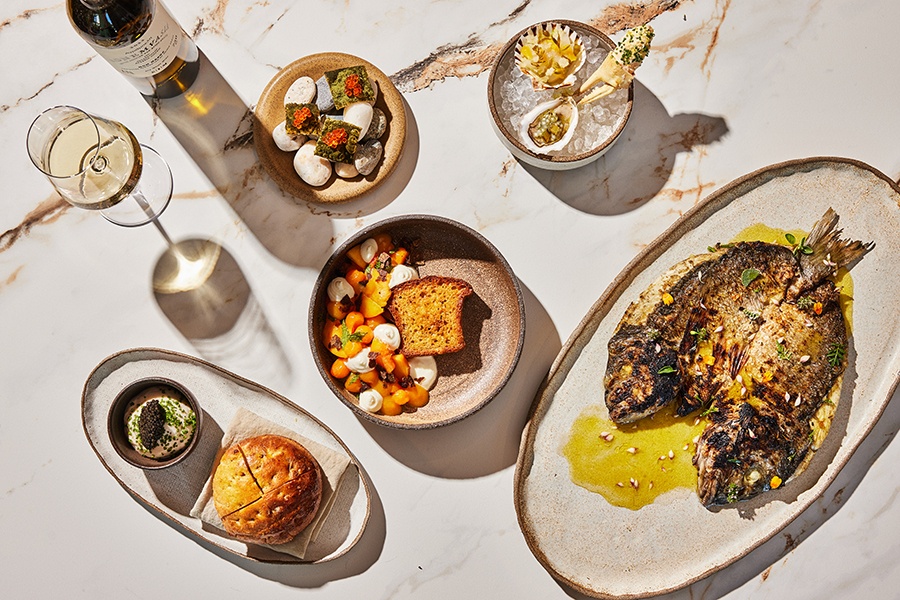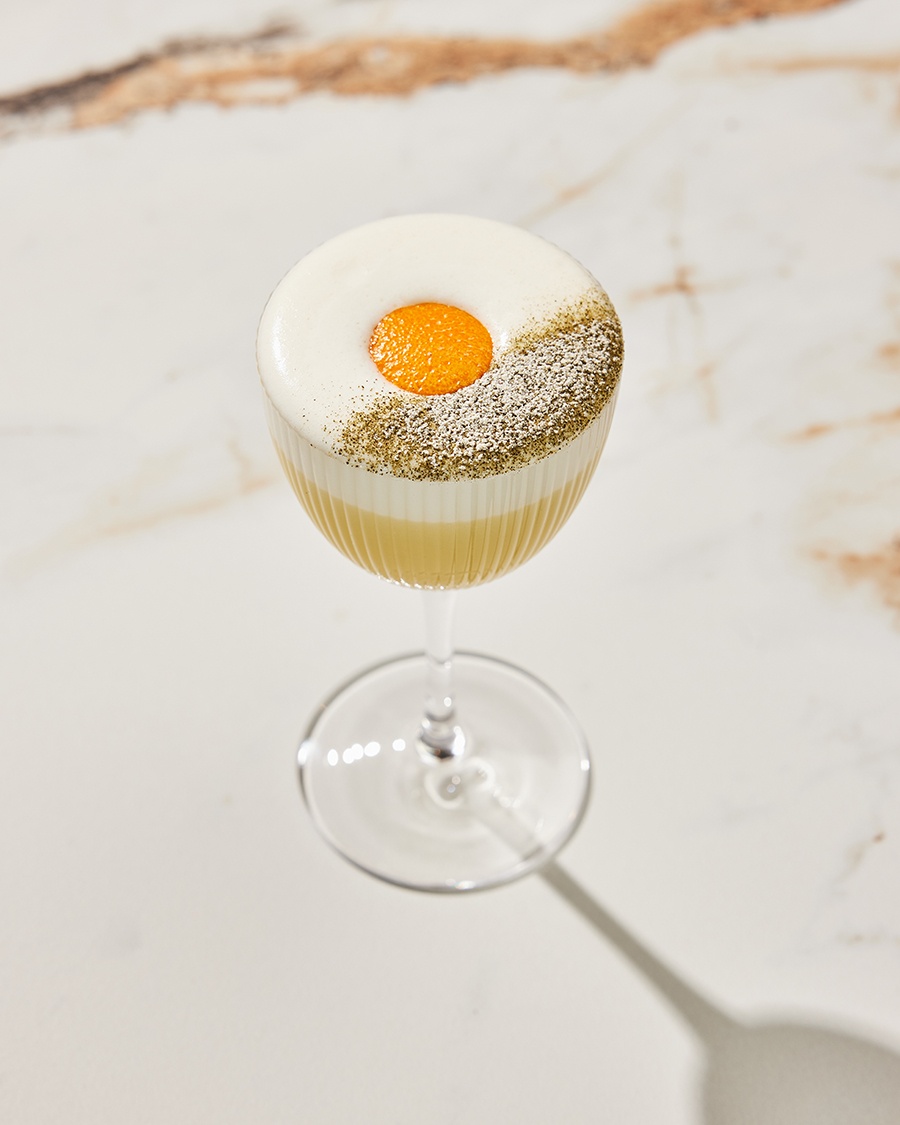Kaia, a Coastal Greek Restaurant, Opens This Fall in Boston’s South End
The next Greek restaurant from the team behind Krasi and Bar Vlaha leans into an Aegean theme of “fishing, feasting, and foraging.”
Kaia, arriving in Boston’s South End in early October, is an ode to the beachy spirit of Greece’s Aegean islands and to modern coastal Greek dining. Think “fishing, feasting, and foraging,” says Demetri Tsolakis, CEO of Xenia Greek Hospitality, the team that’s also behind Krasi and Bar Vlaha.
For Tsolakis, the aim is to evoke a vision of a day in the Aegean, hungry after sun-kissed hours at the beach. Still in your swimsuit, feeling carefree, you grab a table at the local taverna and eat the fresh catch of the day. On the islands, “you don’t have to care about what you’re wearing; you don’t have to care about reservations,” he says. “When you’re hungry, you eat, and there’s always something waiting for you.”
Xenia’s third restaurant is also a response to what Tsolakis sees as an increasingly stressful dining scene, where you often need to book reservations weeks out at many local spots. At Kaia, the emphasis will be on non-reservable tables, not to mention two dozen bar seats. “Who knows who’s going to be hungry at 7 p.m. on a Thursday in two weeks?” says Tsolakis. Wear your metaphorical swimsuit and just show up.
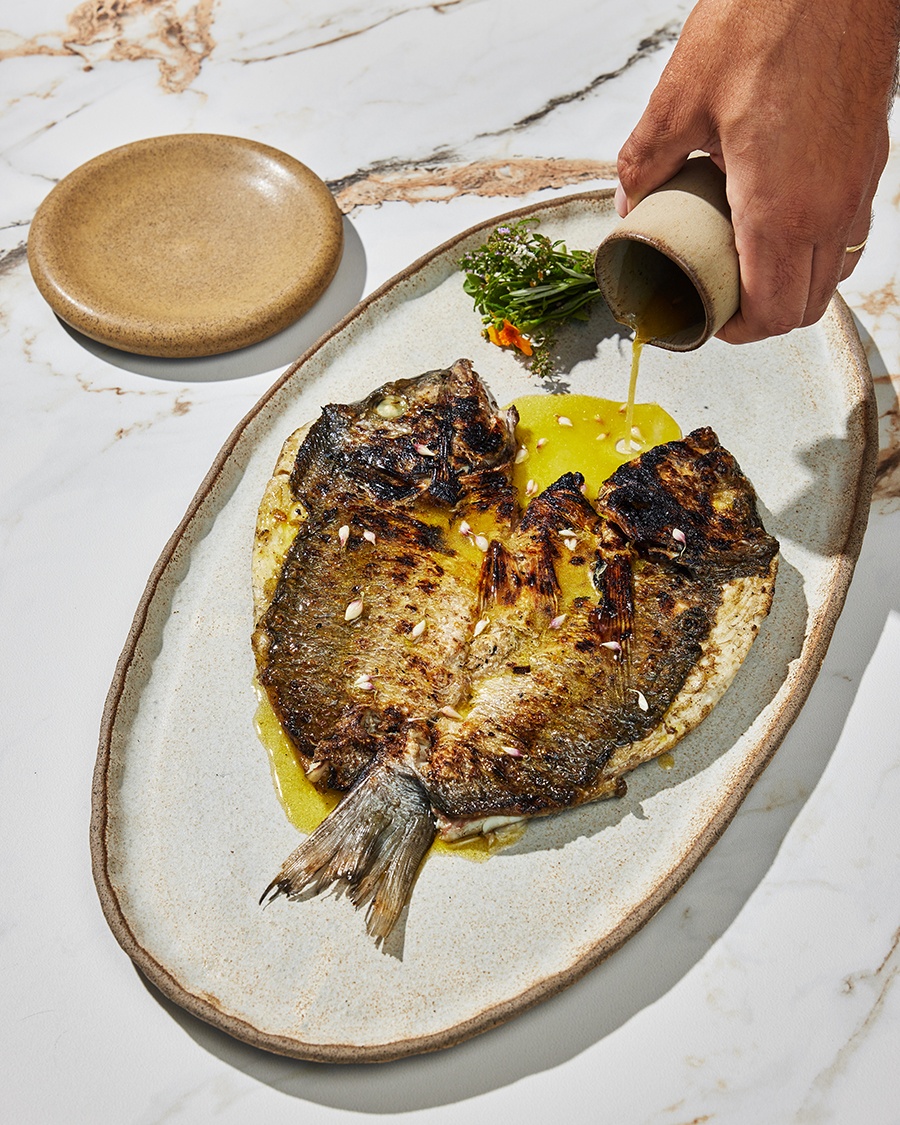
Kaia’s grilled whole fish: tsipoura with orange blossom honey, ladolemono, and herbs. / Photo by Joe St.Pierre
If big sibling Bar Vlaha is any indication, this group knows a thing or two about deep diving into regional cuisine. At Kaia, Xenia culinary director Brendan Pelley and Kaia executive chef Felipe Rodrigues are going all-in on “the gifts of the sea,” as Tsolakis describes the cuisine’s focus, along with other ingredients prevalent on the islands between mainland Greece and Turkey: tomatoes, capers, legumes, potatoes (the island of Naxos even has a potato festival), sea fennel, rock samphire, and more. “They eat a very, very different diet [on the islands],” says Tsolakis. “The great thing about coastal Greek is that everything is shared, everything is fresh, everything is local.”
While the menu will rotate quite a bit, whole fish preparations will always be a highlight. One might find, for example, grilled whole tsipoura (also known as dorado), prepared simply with: orange blossom honey; ladolemono, a lemon and olive oil dressing; and fresh herbs, snipped over the fish at the table. Dakos, a sort of bread salad, will likely stick around year-round, too, although some accoutrements will change seasonally. The version planned for opening features barley rusks, golden cherry tomatoes, nectarine gel, candied kalamata, Anthotyro (cheese), and bread amino, a soy sauce-like condiment prepared over several months in-house using burnt and ground up leftover bread mixed with koji, water, and salt.
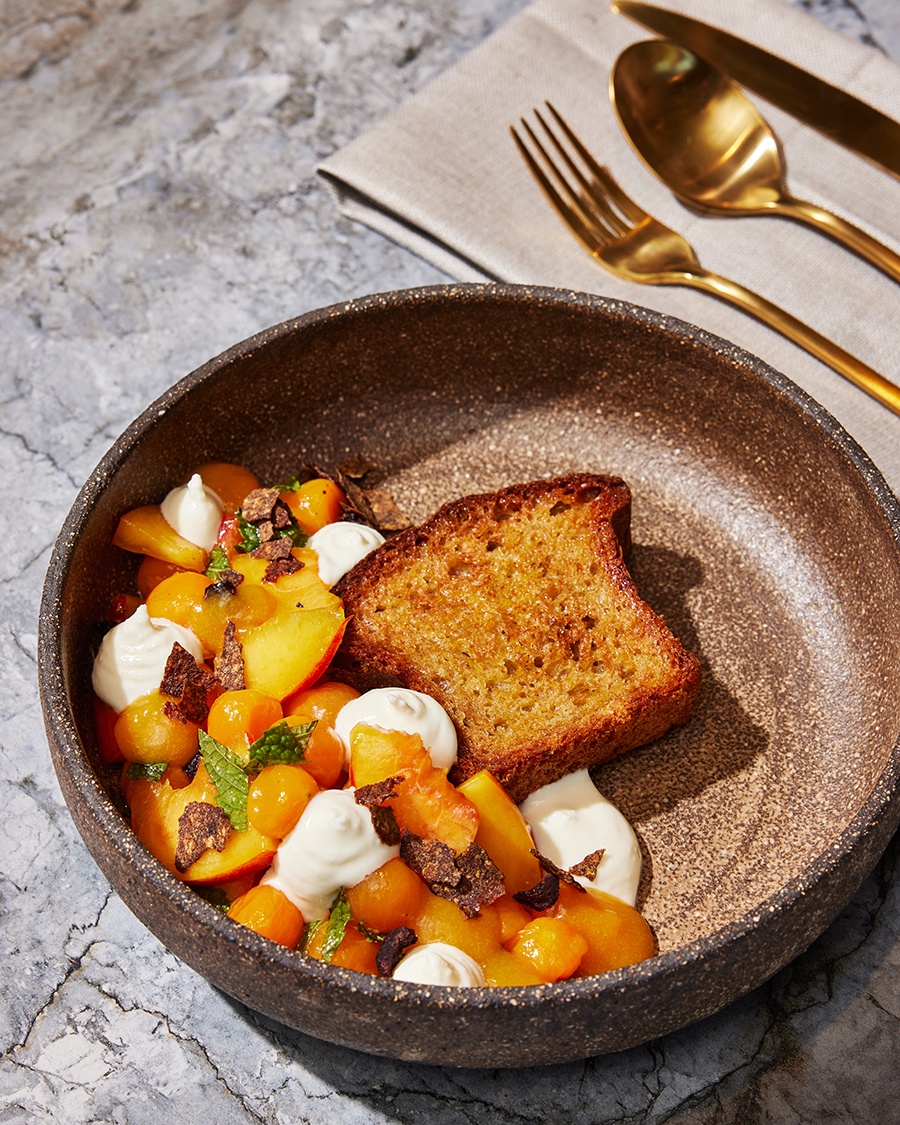
Kaia’s dakos: house barley rusk, golden cherry tomato, nectarine gel, bread amino, anthotyro, candied kalamata. / Photo by Joe St.Pierre
The bread amino process isn’t the only Asian-inspired touch on the menu. Kaia has two Binchō-tan (charcoal) grills, which are typically used in Japanese cooking. A lamb carpaccio and razor clam dish features a Greek spin on XO sauce, which originated in Hong Kong. And kombu, an edible kelp seen often in Japanese cuisine, is used in the curing of a scallop in pikilia, a trio of shellfish preparations. These bits of Asian inspiration reflect what you’ll see in modern tavernas around the region, especially touristy islands like Santorini, says Pelley. “These techniques are a part of contemporary cooking style now, because they make food more delicious. Any restaurant can grill a beautiful fish and use gorgeous olive oil and lemon and fresh herbs, so let’s think about [this cuisine] in a different way. How can we honor the traditions of Aegean cuisine, but dress it up for the modern era?”
The regional focus continues onto the wine list, which is entirely sourced from the Aegean. Most of these vineyards are small, so Kaia’s selection will rotate frequently (and everything’s available by the glass). Only 300 bottles of Mastori Koumariano, for instance, made it to the U.S. from the island of Andros, so if you want to try the “dynamic, light red,” as wine director Evan Turner describes it, you’ll want to come to Kaia. Another highlight of the list is the Kir-Yianni Monemvasia, from winemaker Stellios Boutaris. It’s “bright, crispy, racy, and clean,” says Turner, a perfect pairing for a seafood feast.
“Greeks drink wine to complement food,” says Tsolakis, so in general Kaia’s wines are “fresh and crisp, like a day at the beach.”
The cocktails, too, are built to complement the menu, showcasing Aegean flavors “in a package that is comfortable and familiar without reinventing the wheel,” says beverage director Lou Charbonneau. “We modulate the classics in a way that’s appropriate to accent these flavors while keeping them bright, snappy, and refreshing like you’re in the islands.” Take the Fig Leaf and Mandarin Sour: It’s a play on a gin sour but with acid-adjusted mandarin (brought up to the acidity of lime) instead of the more typical lemon or lime. Fig leaf adds “nice grassy vanilla coconut notes,” says Charbonneau, “which pairs nicely with brighter gins.” (The team uses Tanqueray 10 for this drink.) Albumin, an egg white-derived powder, adds body, and a bit of Ikarian honey nods to the islands.
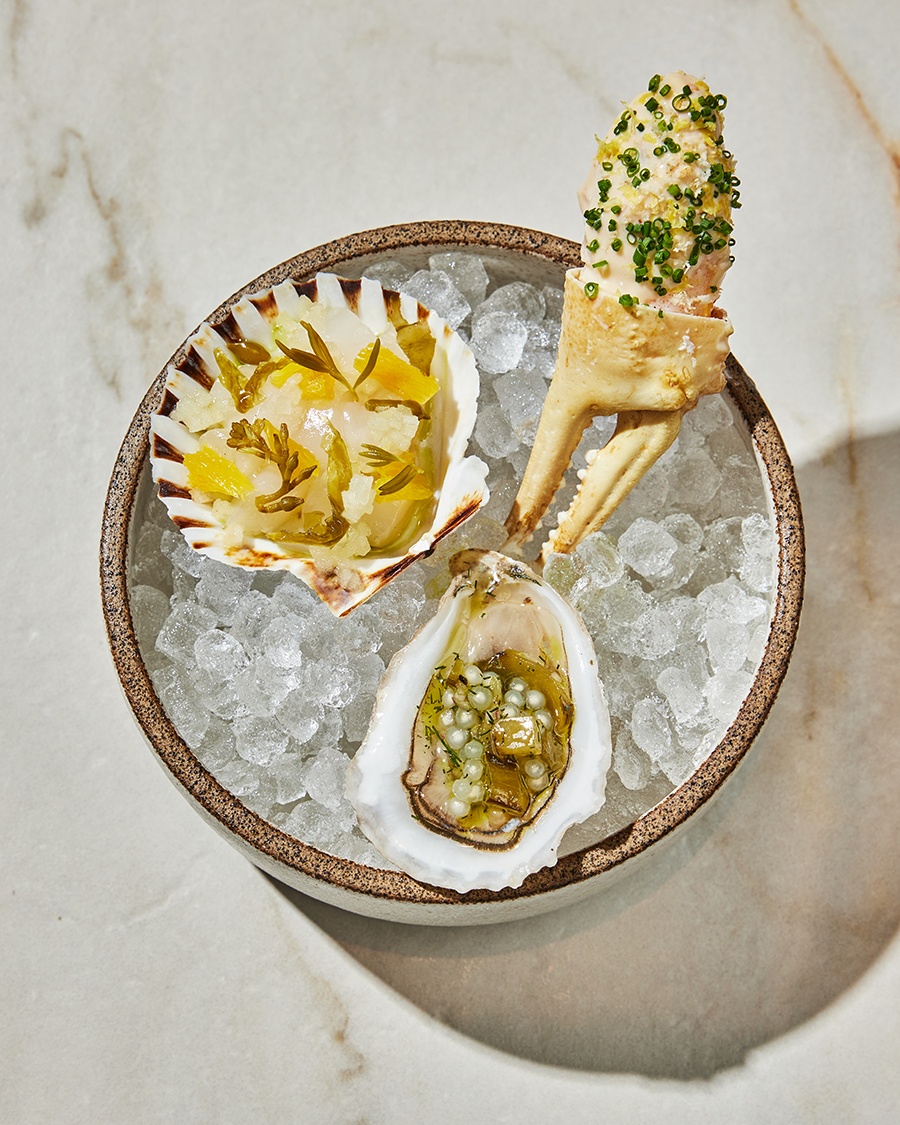
Kaia’s pikilia, a trio of raw shellfish preparations: oyster dressed with charred cucumber, pickled prawn, and tapioca pearls; kombu-cured scallop with foraged, pickled sea vegetables; snow crab claw with a cocktail sauce made of mayo and petimezi (Greek grape must). / Photo by Joe St.Pierre
The Kaia space is “very airy and elegant, but not pretentious,” says Tsolakis. “It has the textures and feels of the Aegean, that whole carefree [feel].” Greece-based designer Panos Efstratiou of RFORM, who has worked with Xenia on other projects (including otherworldly cocktail bar Hecate), designed the Kaia space with an interplay between earthy tones and airy elements, as Efstratiou describes the under-construction space. A “great stone bar” will sit at the heart of the restaurant, and Kaia will also have outdoor dining.
When Kaia opens this fall, the Xenia team hopes to show that “there’s more [to Greece] than just the streets of Athens,” says Tsolakis. “There are islands and villages, and every one of our concepts is a continuation of the map of Greece.” And while the region changes from restaurant to restaurant, the constant is hospitality. Or as Tsolakis puts it, “Our mission is always getting our guests to feel like family.”
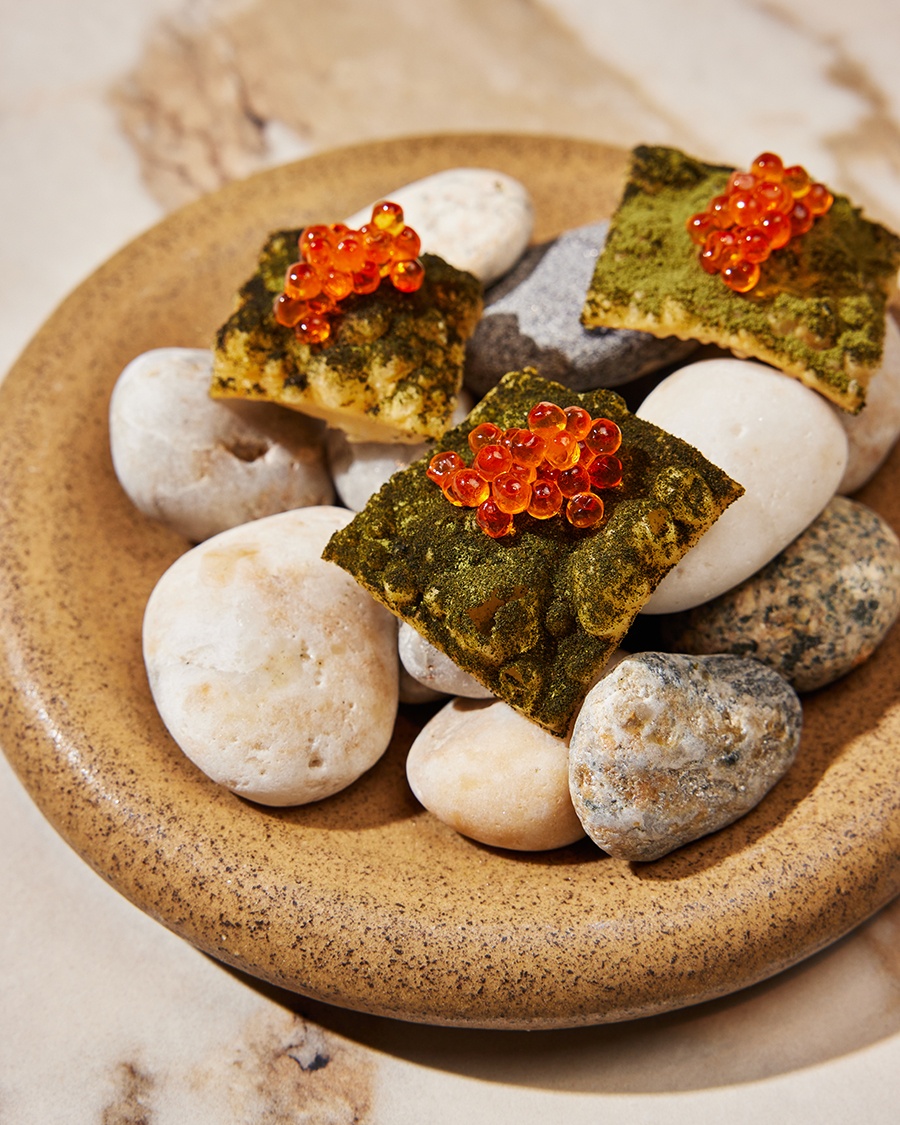
Kaia’s tiropita xynomizithra with smoked trout roe and spice powder, little fried dough puffs stuffed with a cheese filling that has been folded with fermented garlic scapes. / Photo by Joe St.Pierre
Opening in early October. 380 Harrison Ave. (the Quinn), South End, Boston, kaiasouthend.com.
A version of this story appeared in the print edition of the October 2024 issue with the headline, “Aegean Dreams.”
